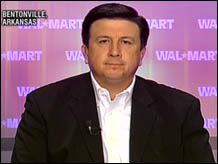|
|
|
|
|
|
|
|

|
| A Wal-Mart official talks about the company's role in the Katrina recovery effort. CNN's Soledad O'Brien reports (September 8) |
Play video
|
|
|
|
NEW YORK (CNN/Money) -
Kudos to Wal-Mart -- on two fronts.
First, the world watched as Wal-Mart (Research) quickly galvanized efforts to help Katrina victims within hours of the catastrophe. Second, by doing so, the world's largest retailer seems to have achieved the unthinkable -- silencing its many critics.
Still, industry watchers and branding experts are divided as to how long the second effect will last.
As the nation's largest private-sector employer with more than 1.3 million workers in the United States alone, the company has attracted dozens of lawsuits against it alleging pay and labor violations and gender discrimination. It's also drawn fire for stifling small businesses and squeezing its vendors.
Then came Hurricane Katrina.
Marshal Cohen, chief industry analyst with market research firm NPD Group, thinks the storm will mark a turning point in Wal-Mart's ongoing efforts to fix its image.
"Short-term, you could think of all the media exposure as a promotional vehicle for Wal-Mart," Cohen said. "But I see longer-term benefits too. Most people who were dramatically affected were Wal-Mart consumers. They're going to remember Wal-Mart was there."
Cohen sees Wal-Mart capitalizing on its experience to help redefine itself to consumers .
"Hurricanes will occur again. The message they want to give people is that when the Red Cross shows up, Wal-Mart will be there right behind them," Cohen said.
Deutsche Bank analyst Bill Dreher agreed.
"Wal-Mart's really stepped up," said Dreher. From a public relation's standpoint, he credits management for hitting the right notes, specifically CEO Lee Scott's meeting with former Presidents Bush and Clinton.
"Is all this a solution for the bigger concerns of the American consumers or the local gas station owner? No," said Dreher. "But it is an example of the company trying to show its heart in the right place."
But others industry watchers weren't so sure.
"This was an opportunity for Wal-Mart to present itself as a good corporate citizen," said Bill Schley, a branding expert with Connecticut-based brand consultant David Inc. "If it didn't, it would be criticized for it. Because it did, people are nodding their heads saying this is what Wal-Mart and other companies should be doing."
But ultimately, he added, "It's very hard to change brand-perception in the short-term."
Branding expert Alan Siegel of SiegelGale, a New York-based strategic branding firm, also expects only a short-term boost for Wal-Mart's image.
"Wal-Mart isn't the only company making corporate contributions. Several companies are actively contributing," Siegel said. "At the end of the day, this company still has a very steep hill to climb because its problems are too endemic."
Wal-Mart did not immediately respond to CNN/Money's calls for a comment.
Next: Cheering up Wall Street?
Wal-Mart currently accounts for nearly 10 percent of the $4.1 trillion in U.S. retail sales but hopes to increase that to about 30 percent over time. How?
Speaking at a Goldman Sachs retail conference in New York this week, Wal-Mart CFO Tom Schoewe said its giant "supercenter" stores will be the biggest component of U.S. growth in the years ahead.
Wal-Mart already operates more than 1,700 U.S. supercenters which sell groceries, along with 1,350 discount stores and 85 other outlets. Such a large fleet of stores has raised concerns about Wal-Mart saturating its home base, with further expansion possibly cannibalizing sales from its own existing stores.
No doubt, Wal-Mart's sales at stores open at least a year -- a key measure known as same-store sales -- have softened, leaving it behind rival discounter Target Corp (Research). And Wal-Mart stock has been stuck between $45 and $60 a share for the past five years
Schoewe prefers to use the term "market development" instead of "cannibalization."
While he acknowledged that Wal-Mart's strategy of opening the new stores near older ones will dent sales of existing stores, it's a risk Wal-Mart is willing to take.
"The financial justification of opening store B near store A is based on incremental sales generated from store B," Schoewe said. "Same-store sales are important but we're focused on overall growth in a market which will ultimately influence overall growth for the company." His remarks were monitored via Web cast.
One hedge fund manager, who declined to be named, said Wal-Mart's cannibalization strategy is making many fund investors uneasy. "Why doesn't Wal-Mart focus on entering new markets or penetrating urban markets with its smaller neighborhood stores instead?" he asked.
Deutsche Bank's Dreher, who has a "buy" rating on the stock, says he understands the strategy.
"Wal-Mart wants to fill out the area around its distribution centers," he said. "By moving into a new area, Wal-Mart first has to set up a new distribution center and then the stores. Expenses go up, and profits come down. By simply adding stores in an existing market, it can leverage infrastructure already in place."
At the same time, Dreher said, Wal-Mart needs to tweak its merchandise mix, add higher-price items to attract more moderate-income consumers -- all to offset the pressure of gas prices on the company's mostly lower-income clientele.

|